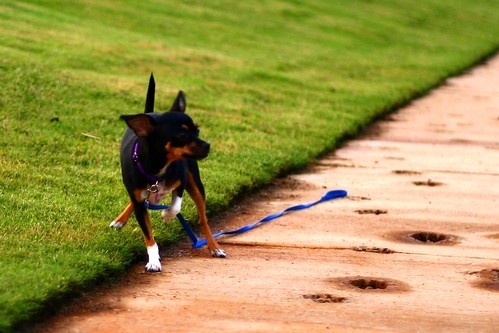 A simple search on Google for “leash pulling” brings up a lot of different products that claim to end the days of your dog dragging you around the block. Could it really be that simple? A collar/harness/leash attachment/doo-dad can solve one of the most prolific dog behavior problems all for only $19.95?
A simple search on Google for “leash pulling” brings up a lot of different products that claim to end the days of your dog dragging you around the block. Could it really be that simple? A collar/harness/leash attachment/doo-dad can solve one of the most prolific dog behavior problems all for only $19.95?
Well, I really don’t think it is that simple. A search for any common dog behavior issue will bring up a lot of ‘miracle products’ that claim to end bad behavior with a single swipe of your credit card. The truth is, these products are really just cashing in on our desire for instant gratification without all the work. If dog training were easy, everyone would have a well-behaved dog walking by their side without pulling, lunging or barking excessively who brings you your slippers to you when you ask, without de-stuffing them first.
Don’t get me wrong, there are some products available that can help while you are training your dog to walk on a leash properly, but first, let’s get familiar with some common training methods to teach loose leash walking. These techniques are ones I’ve used over the years to break my adolescent or adult dog’s bad leash habits, but it is best if you start training your puppy to walk properly on a leash as soon as you bring him home. Remember to reward good behavior with praise or treats occasionally, even long after your initial training.
Stop ‘n Go
 Dogs pull on the leash because it works for them, in the end they get to where they want to go. They also have an opposition reflex, so when they feel the leash tightening up, their instinct is to pull harder. Bring your clicker along for this exercise if you’re practicing clicker training. If your dog puts tension on the leash, stop dead in your tracks as soon as the pulling starts. Don’t say anything; just calmly wait until your dog releases the pressure and looks you in the eye. As soon as he looks at you, mark the behavior with a click/treat or praise, call him back to your side and continue on. Continue the practice throughout the walk. It may take you a long time to get where you are going, and it can take several walks using this method for your pet to make the mental connection that pulling is not an encouraged behavior. It can be helpful to start training inside your house or yard where there are fewer distractions before practicing “loose leash” walking in the park or your neighborhood.
Dogs pull on the leash because it works for them, in the end they get to where they want to go. They also have an opposition reflex, so when they feel the leash tightening up, their instinct is to pull harder. Bring your clicker along for this exercise if you’re practicing clicker training. If your dog puts tension on the leash, stop dead in your tracks as soon as the pulling starts. Don’t say anything; just calmly wait until your dog releases the pressure and looks you in the eye. As soon as he looks at you, mark the behavior with a click/treat or praise, call him back to your side and continue on. Continue the practice throughout the walk. It may take you a long time to get where you are going, and it can take several walks using this method for your pet to make the mental connection that pulling is not an encouraged behavior. It can be helpful to start training inside your house or yard where there are fewer distractions before practicing “loose leash” walking in the park or your neighborhood.
About-Face
About-Face uses a direction change rather than a complete stop, to help break your dog of his leash-pulling habit. This time, instead of stopping when your dog pulls, turn around to change directions with a happy “let’s go!” and start walking the other direction for a few yards. When they are walking calmly, you can start walking the other direction again, towards a desired destination. The reward, in this case, instead of a treat or a click is getting to the place they want to go or inspect, but the only way they’ll make it there is if they do not pull on the leash. This method, too, can take some time and patience to master, like all training methods. Remember to praise good behavior frequently. Keep your cool, if you get frustrated your dog can sense that and will likely not perform the way you’d like. At that point, it is best to return home and try again later.
Lure and Reward
 Another method I’ve used to curb stubborn dog’s leash pulling is with lots and lots of treats. It is helpful to have a treat bag on your hip filled with lots of bite size tidbits. I’ve used this method for dogs that are particularly stubborn when there is another dog or distraction around, or if the other methods aren’t working in that situation. Hold a treat at the dog’s eye level by your side and walk forward. Your dog should follow the treat and forget the distractions across the street. As long as they are focusing on you and the treat, and not on the distraction, you can give them the treat and lots of praise. It takes a lot of will power for your dog to ignore the distractions and focus on you. Be sure to reward it accordingly. I use this method sparingly and in conjunction with the other methods because of all the extra calories they may be consuming.
Another method I’ve used to curb stubborn dog’s leash pulling is with lots and lots of treats. It is helpful to have a treat bag on your hip filled with lots of bite size tidbits. I’ve used this method for dogs that are particularly stubborn when there is another dog or distraction around, or if the other methods aren’t working in that situation. Hold a treat at the dog’s eye level by your side and walk forward. Your dog should follow the treat and forget the distractions across the street. As long as they are focusing on you and the treat, and not on the distraction, you can give them the treat and lots of praise. It takes a lot of will power for your dog to ignore the distractions and focus on you. Be sure to reward it accordingly. I use this method sparingly and in conjunction with the other methods because of all the extra calories they may be consuming.
Heeling
Teaching a dog to heel is usually one of the commands you will learn in more advanced obedience classes, and can be applied after “loose leash” is mastered. I haven’t taken a dog to ‘obedience school’ since I was a teenager, and while I never mastered this skill, it can be useful in training. Used correctly, this command is used to get your dog to be walking very close to your left leg, continuing to walk there until they are released. This command is best utilized for short spurts such as crowded situations or if children or other dogs are around, not for long leisurely walks.
Autumn is a beautiful time to go for long walks with your dogs in the crisp, cool weather. Start leash training now so you can both enjoy longer, more frequent walks that don’t feel like a chore. Good Luck!
 That Pet Blog That Pet Place Pet Blog
That Pet Blog That Pet Place Pet Blog

For me & Jake, the About Face method has been amazing! He didn’t seem to respond to anything else, but that one has been a gem! You’re right that it takes a lot of patience but it’s worth it 🙂